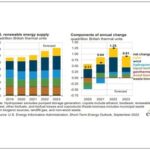EIA updates 2021, 2022 bioenergy forecasts
Energy Disrupter
ADVERTISEMENT
The U.S. Energy Information Administration released its latest Short-Term Energy Outlook on April 6, predicting that 21 percent of U.S. electricity generation will come from renewable sources this year, increasing to 22 percent next year. Renewables accounted for 20 percent of U.S. electricity generation in 2020.
The electric power sector generated 27.5 billion kilowatt hours (kWh) of electricity from biomass last year, including 16.1 billion kWh from waste biomass and 11.4 billion kWh from wood biomass. Biomass power generation is expected to increase to 31.6 billion kWh this year, including 17.2 billion kWh from waste biomass and 14.6 billion kWh from wood biomass, and 32.5 billion kWh in 2022, including 17.3 billion kWh from waste biomass and 15.1 billion kWh from wood biomass.
Across other sectors, biomass generation was at 28.6 billion kWh in 2020, including 2.7 billion kWh from waste biomass and 25.8 billion kWh from wood biomass. Biomass generation is expected to fall slightly to 28.4 billion kWh in 2021, including 2.7 billion kWh from waste biomass and 25.7 billion kWh from wood biomass. Those levels of generation are expected to be maintained through 2022.
The electric power sector is expected to consume 0.154 quadrillion Btu (quad) of waste biomass in 2021, increasing to 0.257 quad in 2022. The sector consumed 0.238 quad of waste biomass in 2020. The electric power sector is also expected to consume 0.234 quad of wood biomass this year, increasing to 0.245 quad in 2022, up from 01.185 quad in 2020.
The industrial sector consumed 0.156 quad of waste biomass last year, with consumption expected to increase slightly to 0.157 quad this year, returning to 0.156 quad next year. The sector also consumed 1.376 quad of wood biomass last year, with consumption expected to increase to 1.394 quad in 2021 and 1.412 quad in 2022.
The commercial sector consumed 0.036 quad of waste biomass last year. That level of consumption is expected to be maintained through 2021 and 2022. The sector also consumed 0.083 quad of wood biomass in 2020. The sector’s consumption of wood biomass is expected to fall slightly to 0.082 quad this year and be maintained at that level through 2022.
The residential sector consumed 0.458 quad of wood biomass last year. That level of consumption is expected to be maintained this year and next year.
Across all sectors, waste biomass consumption was at 0.43 quad last year, with consumption expected to increase to 0.446 quad in 2021 and 0.449 quad in 2022. Wood biomass consumption was at 2.101 quad in 2020 and is expected to increase to 2.168 quad in 2021 and 2.197 quad in 2022.
The electric power sector had 6,574 megawatts (MW) of biomass capacity in place at the end of 2020, including 3,863 MW of waste biomass capacity and 2,711 MW of wood biomass capacity. Biomass capacity is expected to fall to 6,474 MW by the end of this year, including 3,906 MW of waste biomass capacity and 2,568 MW of wood biomass capacity. Capacity is expected to increase slightly to 6,478 MW by the end of next year, including 3,910 MW of waste biomass capacity and 2,568 MW of wood biomass capacity.
Across other sectors, biomass capacity was at 6,418 MW at the end of 2020, including 801 MW of waste biomass capacity and 5,616 MW of wood biomass capacity. Capacity is expected to fall to 6,391 MW by the end of 2021, including 803 MW of waste biomass capacity and 5,589 MW of wood biomass capacity. Biomass capacity is expected to be at 6,384 MW by the end of 2022, including 803 MW of waste biomass capacity and 5,581 MW of wood biomass capacity.
















